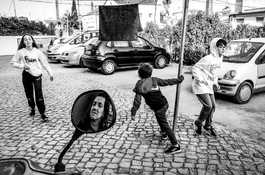I disagree that 'colorful' or 'urban' is somehow an inherent part of chaos in a photographic sense. I think the discussion can (and should) be understood to encompass also chaos that is not necessarily colorful or even perfectly monochrome, and that exists regardless of social context (i.e. it can be entirely natural).
View attachment 400062
You left out the important category that among others @gary mulder is referring to and that @MattKing showed some excellent examples of. I think that's the category that in the context of @Daniela's question is the most relevant one. I base this on a distinction that I think can be drawn between two broader categories of strategies to cope with 'chaos'. The first category relates to the strategies your refer to, and that I would summarize as attempts to reduce the chaos to a simpler form, specifically by isolating a small subset from the chaotic situation that no longer represents the original chaos. The second category is one in which the photographer attempts to capture the chaos in such a way that it retains the complexity of the original scene, but makes the chaos seem more logical and therefore more palatable to the viewer.
It's the second category that piques my interest and that I feel should at least not be excluded from the discusson, and probably (for the record: my conviction, on personal, non-moderator title) is a good candidate to be made the central focus of the discussion. My reasoning is that the former class of strategies effectively attempts to negate the original chaos in order to come to a solution - which results, critically put, in a bypass or workaround at best. The cynic in me would argue that if this route is chosen, one might as well not seek out the chaotic scene in the first place and stick to more serene settings that lend themselves to inherently more quiet and simple compositions.
W.r.t. the second (IMO more relevant) category, I struggle a bit in formulating what it intends to achieve - I've settled for something I'm not entirely happy with, i.e. to make "the chaos seem more logical and therefore more palatable to the viewer". this is inherently problematic, and perhaps therefore also quite interesting, because what is palatable depends on the viewer. This carries the potential for enormous individual variance in it, as well as the influences of cultural programming. Why this is 'quite interesting' is that the appreciation of works of e.g. Wall (see @MattKing's post) prove that despite this evident variance in personal taste, will and ability to comprehend or simply patience to look at a busy photo, there is some degree of universality to compositional patterns that are appreciated. Trying to understand (perhaps intuitively more so than academically) such patterns is one of those fascinating aspects that make rare threads like this one potentially quite interesting. Provided we pick up the glove - and recognize it's a glove in the first place.
Oh yes the second category is the most interesting to me too, trying to make chaos work as a whole, but I didn't mention it because I consider it very difficult.
A similar (if not more difficult) chaos can be found in photographing nature. For example your photo with the river and the two trees worked well into bringing it together as a whole.
Here is a photo of a friend of mine who happens to be a very good photographer too (Angelos Balatsas) where chaos gets structured











